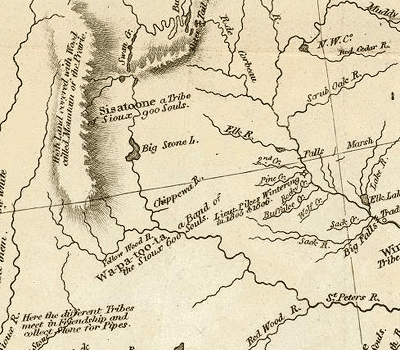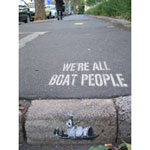Found 3599 matches from 1,400 records in about 0.1547 seconds for twitter or is or lazy.
One of the failures of the emergency response on September 11, 2001 was the inability of the New York Police Department and Fire Department to coordinate their activities.
So as a new policy for emergency response was debated, I’d assumed the battle for control in a disaster was one of power between two muscular (mostly) white, male institutions* (mostly) immune from external accountability. Or to put it to a kinder scenario, one of two long-standing, insular city bureaucracies unwilling to bend to the other.
Who would you want in control? One has experience with hazardous materials, the other with crowd control. One carries axes, the other guns.
So what does this have to do with design?
A friend who works for the city put it differently. She cast the dispute in terms of the departments’ relationships to the built environment:
The first response of the NYPD is to quarantine and preserve the evidence at the scene of the crime.
The response of FDNY is to enter forcefully and tear up the scene looking for survivors and hidden fire.
How exactly should they work together?
* As of 2005, FDNY was 92% white and only 28 of the department’s 8,700 firefighters were women. [source] As of 1999, NYPD was 67.4% white and in 2001, 17 percent of sworn personnel were women. [source, source]
“A pamphlet, no matter how good, is never read more than once, but a song is learned by heart and repeated over and over. And I maintain that if a person can put a few common sense facts into a song and dress them up in a cloak of humor, he will succeed in reaching a great number of workers who are too unintelligent or too indifferent to read.”
— Joe Hill
Longshoreman, wobbly, singer, song-writer, organizer, revolutionary
Yesterday saw a hit to this entry in my referer log from ‘ombpxy.nyc.gov’ using a Google Blog search for ‘nypd.’ Is that the NYC Office of Management and Budget?
Given the petty things friends have been arrested for lately, I should probably be more paranoid than I am, but I think this is a good thing.
Not quite eDemocracy (and who knows how the information will be used) but it’s nice to know at least someone’s checking the comments and complaints box.
At least amongst bloggers.
From an ITConversations recording of David Rumsey’s presentation at the Where 2.0 Conference, June 29, 2005:
“Land surveys in the 19th century began to help divide the country for settlement and political division by drawing patterns on the land. The notion of ‘land ownership’ invades the West with devastating effects on Native Americans....
Here we can see what happened with Indians in Lewis and Clark’s map of 1814. The Sisseton tribe and the Wahpeton tribe are ranging over large areas of land:
A Map of Lewis and Clark’s Track in 1804, Published 1814.
By 1879, they’ve signed a treaty. And now they’re represented by a polygon:
Rand, McNally & Co.’s Business Atlas Containing Large Scale Maps of Each State and Territory of the United States, The Provinces Of Canada, West India Islands, Etc., Etc. 1878-9.
This is sort of the American Experience.Everything is rationalized, surveyed, contained.”
---
In this post I noted how ideology exists spatially. Rumsey’s example powerfully illustrates how notions and representations of spatiality are themselves ideological. With devastating real world consequences.
John T. Unger writes in about his campaign:
“I thought you might be interested in helping spread the word about a call for participation. I’m looking for artists/activists who can help get billboard sized reproductions of Picasso’s Guernica installed in as many US locations as possible.”

From his blog:
“Ideally, the work would stand without any text or headlines or additional commentary: if the painting is all that’s seen, it forces the viewer to make an interpretation instead of being told what to think. Being told what to think is exactly what got Americans in trouble in the first place, no?
In terms of how the project is carried out, I don’t really think it matters whether billboards are rented, plastered over in dark of night (see: BLF, the Billboard Liberation Front) or created just for this purpose. Obviously not everyone has the budget to actually rent billboard space, though it seems like this might be an option for funded activist groups. Now that most billboards are made to hold printed tarps rather than pasted up sheets of paper, it would certainly be easier and faster for guerrilla Guernicas to be painted on canvas and installed at whim. For those who do take the guerrilla approach, it might help to read this basic primer on how to appropriate billboards. Also check out the Wooster Collective for ideas and techniques.
I don’t think it matters whether the images are photos, stencils, handpainted, collaged or what. If the project really took off, part of the excitement would be seeing the results of many different people interpreting a well know work in their own way. I will happily publish any photos sent in by participants of the project.”
The project is, in part, a test of his idea of “open-sourcing art projects” to involve as many participants as possible.
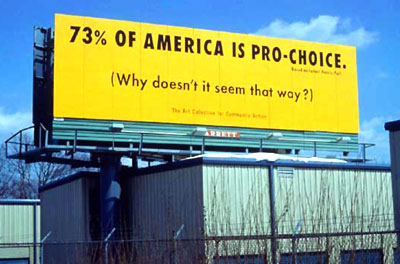
Class Action bills itself as “The Art Collective for Community Action.”
From classactioncollective.org:
“Class Action creates visual messages to advocate social change. Our goal is to influence the way public issues are understood, and motivate audiences to participate in civic dialogue. We work as a collective, authoring, producing and publishing our ideas & initiating projects to illuminate attitudes and conditions overlooked in mainstream media.
Our work originates outside of the studio, with a perception of something taking place in the world. Often beginning with the newspaper or newscast, we define an issue, research it, and craft a message that can lead to some real-world action or change. We work in the spirit of the phrase, ‘pro bono publico’, meaning ‘for the public good’. We endeavor not only to communicate our own position but also to inspire others to become active.
As graphic designers, we have the power to lend authority to messages that would normally be seen on the fringes of society. Through design, we gain access to the official channels of communication & the organizations, institutions, leaders and media that have great sway over social values and priorities. What we place in these channels is an attempt to challenge, influence and provoke.”
Class Action started as just that, in 1992 at the Yale School of Art. Several designers have been associated with the collective since then.
Check their list of public projects. Among them:
- T-shirts and an exhibition on AIDS awareness
- a talk show media kit and T-shirt on the “abortion pill” RU-486
- a poster challenging the gender bias of AIGA
- a billboard on domestic violence
- a public service announcement on teen pregnancy
- and posters on gun control
My personal favorite is this surreptitious pamphlet challenging the AIGA’s commitment to public engagement:
“Washington DC, 2002: The American Institute of Graphic Arts National Conference ‘Voice!’ promises a radically new focus on serious public issues. Yet the AIGA design competitions criteria continue to emphasize form over content. The satirical pamphlet, written and designed to conform to the identity of the conference materials, challenges the AIGA to recognize the purpose and social value of design.”
From the pamphlet:
“New Categories for 365: AIGA annual design competitions
The new competitions will reward design that best works toward:
- Establishing justice
- Insuring domestic tranquility
- Providing for the common defense
- Promoting the general welfare
- Securing the blessings of liberty
- Forming a more perfect union
By the end of voice we trust you will agree that these criteria and categories are what really matter.”
The common defense bit gets a bit murky in this perpetual “war on terror”, but I think the piece hits the right place at the right time. Within the context of the membership conference, it starts to move beyond public awareness into mobilization. Nice to see the Left seizing ‘American-ness,’ too.
I’ve argued here before about how the AIGA and competitions could be a force for change, so it’s nice to see AIGA members taking them to task, too — and nearly a month before I started this blog!
Here’s looking forward to more work — and to keeping the pressure on!
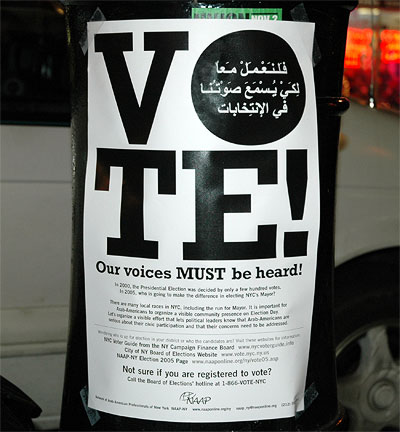
It’s election day today in NYC. I spotted this in Bay Ridge Brooklyn this weekend.
The bilingual poster does not endorse a particular candidate or ballot initiative, simply the vote itself. It’s not trying to sell anything but political power.
The poster reads:
“There are many local races in NYC, including the run for Mayor. It is important for Arab-Americans to organize a visible community presence on Election Day. Let’s organize a visible effort that lets political leaders know that Arab-Americans are serious about their civic participation and that their concerns need to be addressed.”
Political power in New York City can often be drawn among community lines. This often becomes a game of numbers, and graphics in community spaces play a small but important part.
Kimberly from Australia emails:
“[I am writing] to see if you have a copy of Tibor Kalman’s ‘Fuck Bush. Vote’ poster. Reading your post today about the bilingual poster for the NYC elections made me remember Tibor’s and would love to see it.”
Here you go. A shot of page 75 in Tibor Kalman: Perverse Optimist:
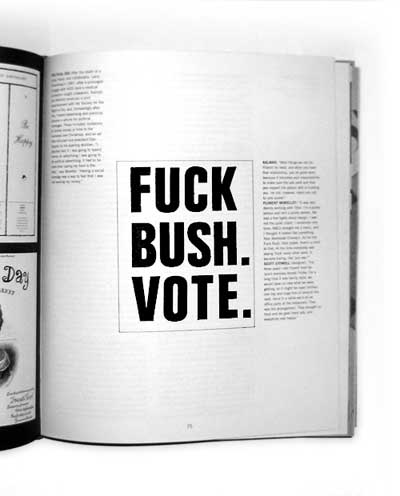
Before his famous “political advertising” for Benetton, Kalman and his company M&Co created such at the behest of Florent Morellet, owner of the eponymous bistro in the meatpacking district.
The text on the page above reads:
“After the death of a close friend, and collaborator Larry Rosenberg, in 1987, after a prolonged struggle with AIDS (and a medical profession caught unawares), Kalman and Morellet produced a joint advertisement with the Society for the Right to Die, and, increasingly after this, Florent advertising and publicity became a vehicle for political messages. These included invitations to donate money or time to the homeless over Christmas, and an ad that ridiculed vice-president Dan Quayle for his spelling abilities.
‘I decided that if I was going to spend money on advertising I was going to do political advertising; it had to be more than saying my food is the best,’ says Morellet. ‘Having a social message was a way to feel that I was not wasting my money.’
Kalman: ‘Most things we did for Florent he liked, and when you have that relationship, you do great work, because it becomes your responsibility to make sure the ads work and that you respect the person who is trusting you. He did, however, reject our call to vote poster.’Florent Morellet: ‘It was very stormy working with Tibor. I’m a pushy person and he’s a pushy person. We had a few fights about design. I was not the quiet client.... As for the Fuck Bush, Vote poster, there’s a limit to that. At the time everybody was saying ‘fuck’ every other word. It became boring, like ‘you see.’’
Scott Stowell (designer): ‘For three years I ate Florent food for lunch everyday except Friday. For a long time it was family style; we would have no idea what we were getting, so it might be roast chicken one day and huge tins of borscht the next. Once in a while we’d do an office party at the restaurant. That was the arrangement. They brought us food and we gave them ads, and everybody was happy.’”
Florent has a history of community engagement. In 2003, with preservationist Jo Hamilton, he helped earn landmark recognition for the Gansevoort Historic District.
The context of the Florent ads, arising from rage and personal loss, and even the barter arrangement, make the feel a lot less crass and gratuitously provocative than Kalman’s later work for Benetton.
---
See previous posts Half Empty on Tibor and Commodify Your Dissent on merchant politics.
The 2008 Beijing Olympics Committee today announced their five Official Mascots:
“Like the Five Olympic Rings from which they draw their color and inspiration, the Five Friendlies will serve as the Official Mascots of Beijing 2008 Olympic Games, carrying a message of friendship and peace — and blessings from China — to children all over the world.
Designed to express the playful qualities of five little children who form an intimate circle of friends, the Five Friendlies also embody the natural characteristics of four of China’s most popular animals — the Fish, the Panda, the Tibetan Antelope, the Swallow — and the Olympic Flame.”
That’s the same Tibetan Antelope now teetering on the edge of extinction — endangered by infrastructure development and poaching. (Its wool is some of the finest in the world.)
The character is intended to project an image of happy diversity:
“His head ornament incorporates several decorative styles from the Qinghai-Tibet and Sinkiang cultures and the ethnic design traditions of Western China.”
Students for a Free Tibet, however, notes another agenda:
“The Chinese authorities’ plan to use the Tibetan antelope as propaganda purporting the unity of the nationalities in China in order to distract from the reality that China has illegally occupied Tibet for more than 50 years can be seen clearly in the statements made at the mascot unveiling ceremonies. According to Liu Qi, head of the Olympics organizing committee, the mascots ‘reflect the cultural diversity of China as a multi-ethnic country... and the enthusiasm and aspirations of our people.’
The Tibetan antelope is not a Chinese symbol and is being used to legitimize China’s occupation of Tibet.”
SFT is encouraging letters to Mr. Liu Qi. For more, see the SFT and Human Rights Watch campaigns on the 2008 Olympics in China.
Like the U.S., Australia has a growing problem of fundamentalists in politics.
In response, graphic designer, artist, and activist Deborah Kelly has undertaken a large scale public art project in the streets (skies and train stations) of Sydney. From bewareofthegod.com:
“This site intends to be a resource of diverse material documenting, analyzing, and musing upon the impacts and aspirations of religious literalists in the public sphere. It is being produced in Australia, in 2005, so that is its first focus. However, you will also find here information, ideas and reportage from other places, because even though context is everything, a global phenomenon is also something.”
The project incorporates multiple media, including:
A 30 second film shown every ten minutes on 42 billboard screens in Sydney train stations, viewable in miniature here [Quicktime 874 Kb]
Projections onto clouds over Sydney Harbor:
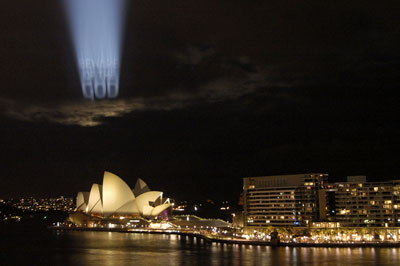
Distribution of 40,000 free postcard/stickers (you can mail or peel the front off and stick to your door.)

And essays and analysis posted on the project Web site. On the site is an open call for further cultural and analytical material.
The effort is backed by the Museum of Contemporary Art in Sydney as part of their biennial Contemporary Australian Art show, this year called Interesting Times.
Related projects from Kelly include a series of posters designed with Tina Fiveash satirizing the right wing regime of “compulsory heterosexuality”.

And a series of illustrated matchboxes satirizing the Christian right push in Australia to have muslim women and girls banned from wearing hijab “because they might be hiding bombs.” Kelly and friends made thousands of satirical matchboxes and left them lying around.

Kelly is also involved in a collective challenging the rhetoric of politicians calling refugees ‘boat people.’ See more at http://www.boat-people.org/
Though not aligned with a specific organizing campaign, I think such cultural work is important in the battle for hearts and minds.
page 1 2 3 4 5 6 7 8 9 10 11 12 13 14 15 16 17 18 19 20 21 22 23 24 25 26 27 28 29 30 31 32 33 34 35 36 37 38 39 40 41 42 43 44 45 46 47 48 49 50 51 52 53 54 55 56 57 58 59 60 61 62 63 64 65 66 67 68 69 70 71 72 73 74 75 76 77 78 79 80 81 82 83 84 85 86 87 88 89 90 91 92 93 94 95 96 97 98 99 100 101 102 103 104 105 106 107 108 109 110 111 112 113 114 115 116 117 118 119 120 121 122 123 124 125 126 127 128 129 130 131 132 133 134 135 136 137 138 139 140 141 142 143 144 145 146 147 148 149 150 151 152 153 154 155 156 157 158 159 160 161 162 163 164 165 166 167 168 169 170 171 172 173 174 175 176 177 178 179 180 181 182 183 184 185 186 187 188 189 190 191 192 193 194 195 196 197 198 199 200 201 202 203 204 205 206 207 208 209 210 211 212 213 214 215 216 217 218 219 220 221 222 223 224 225 226 227 228 229 230 231 232 233 234 235 236 237 238 239 240 241 242 243 244 245 246 247 248 249 250 251 252 253 254 255 256 257 258 259 260 261 262 263 264 265 266 267 268 269 270 271 272 273 274 275 276 277 278 279 280 281 282 283 284 285 286 287 288 289 290 291 292 293 294 295 296 297 298 299 300 301 302 303 304 305 306 307 308 309 310 311 312 313 314 315 316 317 318 319 320 321 322 323 324 325 326 327 328 329 330 331 332 333 334 335 336 337 338 339 340 341 342 343 344 345 346 347 348 349 350 351 352 353 354 355 356 357 358 359 360
[ Back ]
[ Next ]


